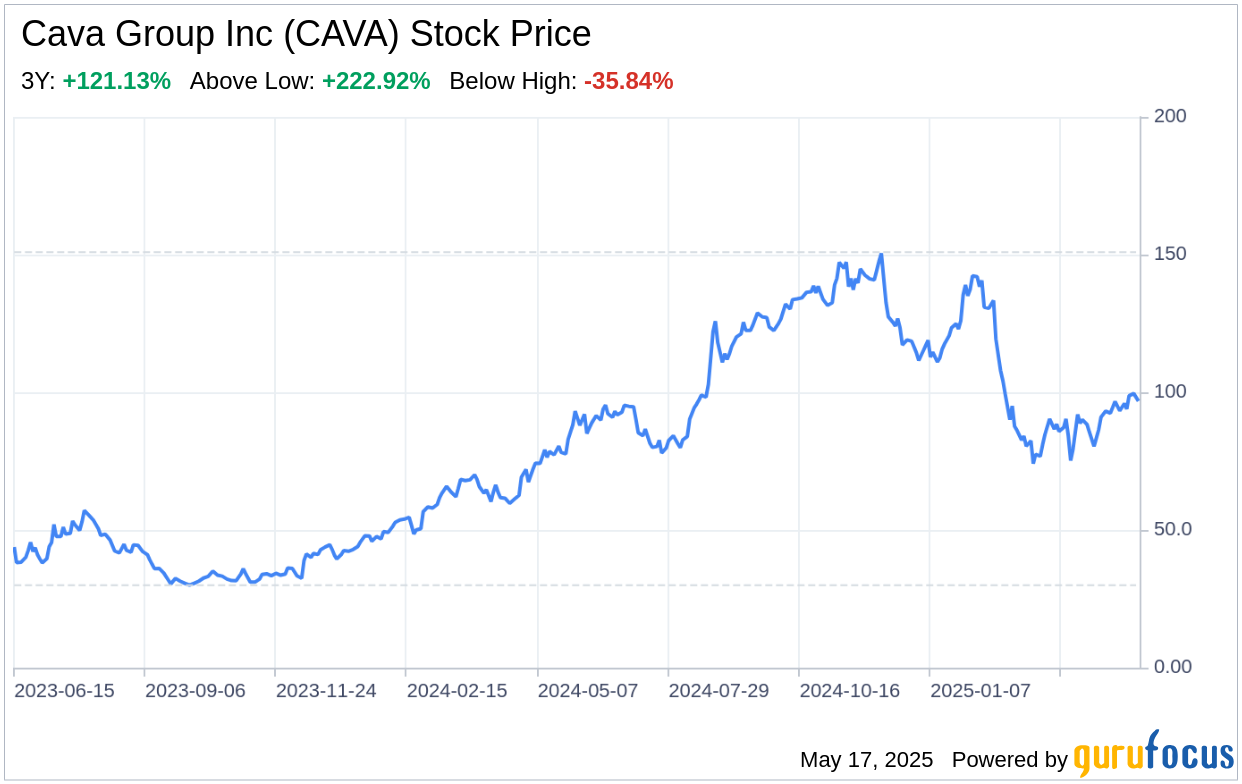On May 16, 2025, Cava Group Inc (CAVA, Financial), a leading chain of Mediterranean fast-casual restaurants, filed its 10-Q report, revealing a comprehensive financial performance for the sixteen weeks ended April 20, 2025. The company reported a substantial increase in revenue, climbing to $331.8 million from $259.0 million in the prior year. Net income also saw a remarkable rise, doubling from $14.0 million to $25.7 million, indicating a strong operational grip and successful execution of business strategies. These financial highlights provide a solid foundation for a detailed SWOT analysis, offering investors a window into CAVA's strategic positioning and future prospects.

Strengths
Revenue and Profitability Growth: Cava Group Inc (CAVA, Financial) has demonstrated a solid financial performance with a significant increase in revenue and net income. The company's revenue surged by 28.1% to $331.8 million, while net income almost doubled to $25.7 million compared to the same period last year. This growth is indicative of a strong brand, efficient operations, and successful expansion strategies. The company's ability to increase its earnings per share from $0.12 to $0.22 also reflects a robust bottom line, which is a testament to its financial health and profitability.
Operational Efficiency: CAVA's operational efficiency is evident in its ability to manage restaurant operating expenses effectively. Despite increases in food, beverage, and packaging costs, as well as labor and occupancy expenses, the company has maintained a steady income from operations, which grew from $9.3 million to $15.7 million. This showcases CAVA's adeptness in controlling costs while scaling its operations, a strength that positions it well against competitors in the fast-casual dining space.
Brand and Market Position: Cava Group Inc (CAVA, Financial) has established itself as a category-defining brand in the Mediterranean fast-casual restaurant segment. With a loyal customer base and a reputation for healthful, bold flavors, CAVA has differentiated itself from competitors. The company's strategic decision to also sell its dips, spreads, and dressings in grocery stores expands its brand reach and creates additional revenue streams, further solidifying its market position.
Weaknesses
Increased Operating Expenses: While CAVA has managed to increase its revenue, the company's operating expenses have also risen, from $249.8 million to $316.1 million. This increase is primarily due to higher restaurant operating costs, including food, labor, and occupancy expenses. As CAVA continues to expand, it will need to find ways to optimize its supply chain and manage labor costs to maintain profitability and competitive pricing.
Dependence on CAVA Segment: Cava Group Inc (CAVA, Financial) generates all of its revenue from the CAVA segment, with no significant contribution from the Zoes Kitchen segment or other business areas. This dependence on a single segment could be a potential weakness, as it may limit the company's ability to diversify revenue streams and mitigate risks associated with market fluctuations in the fast-casual dining industry.
Substantial Investments: The company's pre-opening costs and capital expenditures have increased, indicating significant investments in new restaurant openings and infrastructure. While these investments are necessary for growth, they also reflect a weakness in terms of immediate cash outflows and the risks associated with new market entries and the successful ramp-up of new locations.
Opportunities
Market Expansion: CAVA's strong revenue growth and net new restaurant openings present an opportunity to further expand its market presence. With 73 net new CAVA restaurant openings contributing to a $46.1 million increase in revenue, the company is well-positioned to capitalize on the growing demand for Mediterranean cuisine and fast-casual dining experiences.
Digital and Delivery Channels: The rise of digital orders and delivery services offers CAVA an opportunity to enhance its digital revenue mix and cater to the increasing consumer preference for convenience. By leveraging technology and third-party partnerships, CAVA can drive sales growth and reach a broader customer base beyond its physical restaurant locations.
Consumer Packaged Goods (CPG) Segment: CAVA's presence in the CPG market through its dips, spreads, and dressings provides an opportunity to diversify its revenue and increase brand visibility. The company can explore new distribution channels and product innovations to strengthen its position in the grocery sector and tap into new customer segments.
Threats
Competitive Market: The fast-casual dining industry is highly competitive, with numerous players vying for market share. CAVA faces the threat of competition from both established chains and emerging brands, which could impact its ability to attract and retain customers, as well as pressure margins due to competitive pricing strategies.
Economic Uncertainties: Macroeconomic factors such as inflation, supply chain disruptions, and labor market challenges pose threats to CAVA's operational costs and profitability. The company must navigate these uncertainties while maintaining quality and service standards to avoid adverse impacts on its financial performance.
Regulatory Changes: Changes in regulations related to food safety, labor laws, and health standards can result in increased compliance costs and operational complexities for CAVA. The company must
This article, generated by GuruFocus, is designed to provide general insights and is not tailored financial advice. Our commentary is rooted in historical data and analyst projections, utilizing an impartial methodology, and is not intended to serve as specific investment guidance. It does not formulate a recommendation to purchase or divest any stock and does not consider individual investment objectives or financial circumstances. Our objective is to deliver long-term, fundamental data-driven analysis. Be aware that our analysis might not incorporate the most recent, price-sensitive company announcements or qualitative information. GuruFocus holds no position in the stocks mentioned herein.
